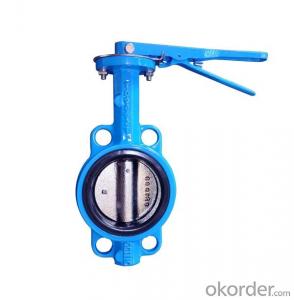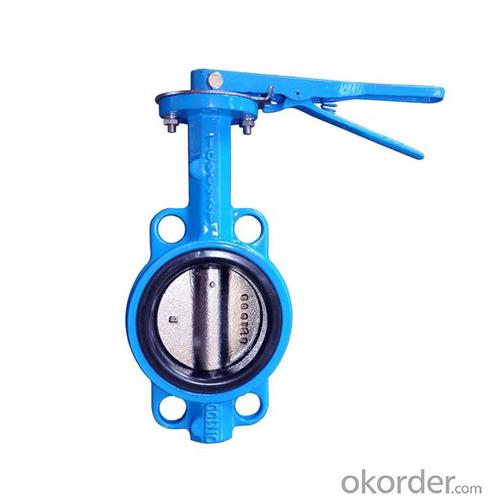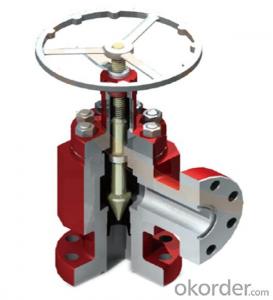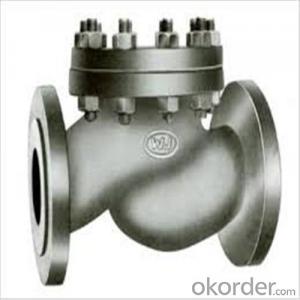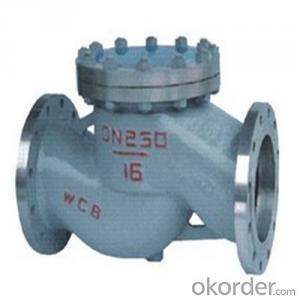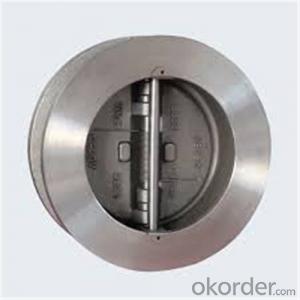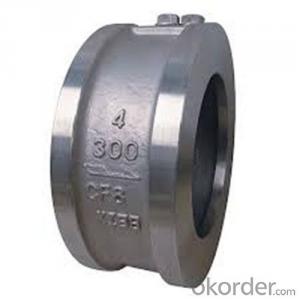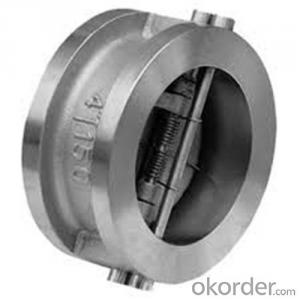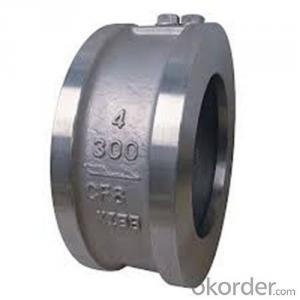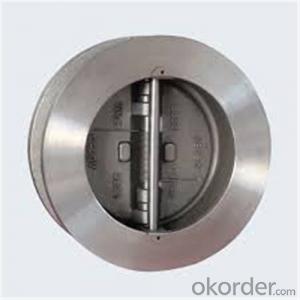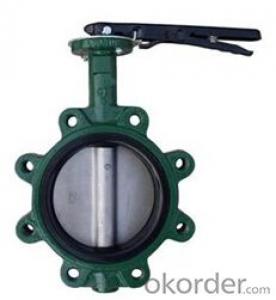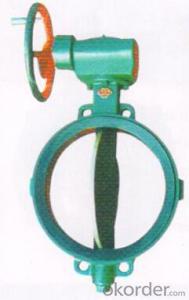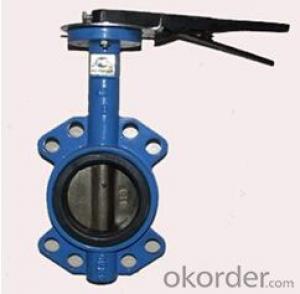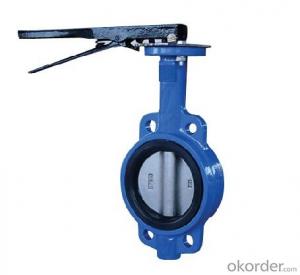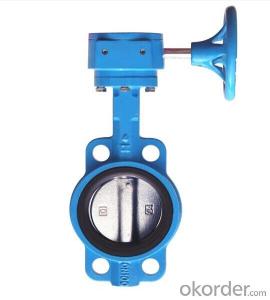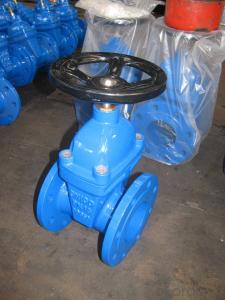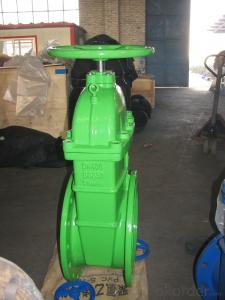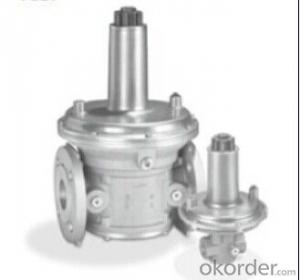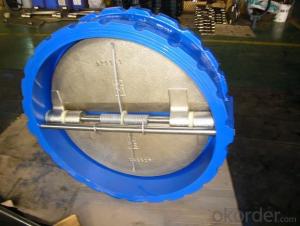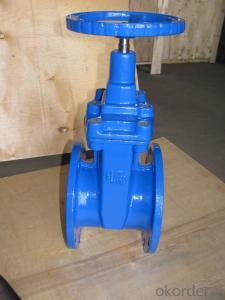DN100 Wafer Type Butterfly Valve BS Standard BS5163
- Loading Port:
- Tianjin
- Payment Terms:
- TT OR LC
- Min Order Qty:
- 1 set
- Supply Capability:
- 5000 set/month
OKorder Service Pledge
OKorder Financial Service
You Might Also Like


General valve using the market long-term, widespread Water Leakage, rust phenomenon, soft sealing gate valve produced by the introduction of foreign advanced technology of the enterprise. To overcome the poor sealing gate valve, general elastic fatigue, rust and other defects. Soft sealing gate valve is a traditional valve replacement products, the compensation effect of using flexible gate produce small deformation, achieve good sealing effect, the valve has a light switch, reliable sealing, good elastic memory and long service life and other significant advantages, can be widely used in water, sewage, construction, food, medicine, metallurgy, electric power, textile, energy systems, fluid pipeline regulation and closure devices as.
The characteristics of:
- flat style seat
The traditional control valve often pass after washing due to foreign objects such as stone, wood, cement, paper, and other debris deposited on the valve at the end of the groove. Close but not close easily lead to the formation of Water Leakage phenomenon, the lower part of the soft sealing gate valve with water using the same flat design, easy to siltation caused by debris, the fluid unimpeded.
And the overall package glue
The valve plate is made of high-quality rubber overall, the outsourcing of plastic, making the domestic first-class rubber vulcanization vulcanization after the valve plate to ensure accurate geometry, and the rubber and ductile iron gate is connected firmly, not easy to fall off and good elastic memory.
And corrosion resistance
The valve body adopts epoxy coating powder, can prevent the corrosion and rust, and can be used for sewage systems.
And not easy to break
Traditional cast iron garden gate often hit foreign objects, collision or overlap caused by the fracture phenomenon. Because the valve to switch to ductile iron, this is the case already significantly reduced.
Three "O" ring seal
As the valve stem with three "0" ring ring seal design, can reduce friction when the switch is greatly reduced, Water Leakage phenomenon and can cut off the water supply construction not replace sealing ring.
And help to drink
Due to the internal body to non-toxic epoxy resin coating, gate of the inner and outer surfaces are completely coated with rubber and can not rust or corrosion of water available to drink.
- Casting valve
Valve body casting, precise geometry makes the body without any internal finishing to ensure that the valve seal.
And light weight
The valve is made of ductile cast, lighter in weight than conventional gate weight about 20%-30%. Convenient installation and repair.
Overview:
General valve using the market long-term, widespread Water Leakage, rust phenomenon, soft sealing gate valve produced by the introduction of foreign advanced technology of the enterprise. To overcome the poor sealing gate valve, general elastic fatigue, rust and other defects. Soft sealing gate valve is a traditional valve replacement products, the compensation effect of using flexible gate produce small deformation, achieve good sealing effect, the valve has a light switch, reliable sealing, good elastic memory and long service life and other significant advantages, can be widely used in water, sewage, construction, food, medicine, metallurgy, electric power, textile, energy systems, fluid pipeline regulation and closure devices as.
The characteristics of:
- flat style seat
The traditional control valve often pass after washing due to foreign objects such as stone, wood, cement, paper, and other debris deposited on the valve at the end of the groove. Close but not close easily lead to the formation of Water Leakage phenomenon, the lower part of the soft sealing gate valve with water using the same flat design, easy to siltation caused by debris, the fluid unimpeded.
And the overall package glue
The valve plate is made of high-quality rubber overall, the outsourcing of plastic, making the domestic first-class rubber vulcanization vulcanization after the valve plate to ensure accurate geometry, and the rubber and ductile iron gate is connected firmly, not easy to fall off and good elastic memory.
And corrosion resistance
The valve body adopts epoxy coating powder, can prevent the corrosion and rust, and can be used for sewage systems.
And not easy to break
Traditional cast iron garden gate often hit foreign objects, collision or overlap caused by the fracture phenomenon. Because the valve to switch to ductile iron, this is the case already significantly reduced.
Three "O" ring seal
As the valve stem with three "0" ring ring seal design, can reduce friction when the switch is greatly reduced, Water Leakage phenomenon and can cut off the water supply construction not replace sealing ring.
And help to drink
Due to the internal body to non-toxic epoxy resin coating, gate of the inner and outer surfaces are completely coated with rubber and can not rust or corrosion of water available to drink.
- Casting valve
Valve body casting, precise geometry makes the body without any internal finishing to ensure that the valve seal.
And light weight
The valve is made of ductile cast, lighter in weight than conventional gate weight about 20%-30%. Convenient installation and repair.


- Q: I saw some other answers. I figure the relief valve needs replacing, ok no problem, but exactly how much pressure are we talking about here? what is the correct procedure to shut this thing down to replace the valve?
- First if you follow the correct procedure the pressure is no problem. 1 Kill the power or gas to the heater-very important for electirc elements will pop if not done before water is drained. 2 Hook up hose to drain on the bottom and open it up to flow water outside of home. 3.Open hot water valve on tub and sink to allow water to drain after you shut off the main water supply. 4.Shut off the main water supply and let tank drain for an hour. 5. Use a pipe wrench to remove old pressure relief valve. 6 Pipe dope new pressure relief valve and install. 7Open main water vlve and close and remove water hose on drain. 8Let water flow out of tub and sink for 5 minutes after air has bled out. 9Turn system back on and be sure check for leaks.
- Q: Okay so my boyfriend's father is getting a heart valve replacement....he's so nervous he cried last night when he heard it will be in 2 weeks....and he's usually one of those tough guys has anyone or know anyone who has had this type of surgery. They are leaning towards a animal (cow or pig) valve...because with mechanical you have to take blood thinners for the rest of your life...anyways if anyone knows information on this or knows the pro's and cons of the two diff. types of valves please give me info. Thanks
- I worked in ICU for 16 years, 8 of them with open heart patients. My dad also had 3 bypasses and 2 valves replaced at age 80. He will celebrate his 89th birthday in May. My dad had the mechanical because being 80, it should last the rest of his life. He does take blood thinners, as do millions of other people in the world. It's really not that big a deal, and if it prevents strokes and other problems related to clots, people accept that. You got a lot of good information in the Answer before mine, so I won't repeat. Just understand that it's perfectly normal to be petrified and tearful and scared about such a major surgery. Even the big macho men feel that way, and many of them had fears long after they had the valve done. It's normal. Attitude is a very big factor in uneventful recovery, those with more positive attitudes got better more quickly. So after the initial shock wears off, be sure that all of you encourage him, listen to his fears but help him understand it's a new lease on life for him and that all of you will be there to help him get back on his feet as quickly as possible. When I first started nursing, people would be in ICU for 4-5 days, then in the hospital another 2 weeks after having heart surgery. My dad was home in 5 days, and that was 9 years ago! Heart surgery has come a long way, and he has every right to be hopeful about the outcome. Good luck to him and all of you!
- Q: I somehow lost the valve cap to one of my tires. Do stores sell replacement caps? If so, would a place like Sears or VIP be a good place to look? If not, would a bike tire valve cap work?In the mean time, i took a cap off the fullest tire to put on this one(the lowest) was that good or bad idea?
- Tire Caps For Cars
- Q: I acquired an old valve guitar amp not long ago and i think it needs new valves trouble is the valves that are in it have no writing left on them and there is one valve completely missing how can i find out what type of valves to put in it. Could i use a multi meter to see what voltage etc is going into the valve socket and then find a valve with matching voltage. Thanks for your help Marc
- Go okorder and search for the schematic diagram for your amp(enter the brand and model of your amp)!
- Q: what the valves adjustment spies in the 1979 Mercury-marine engine, 6 cylinder in-line 165hp 4.089L?
- If it is an outboard 2 stroke there are no vlaves to adjust, it uses reeds in the intake. If it is any type of 4 stroke get a repair manual for proper specs.
- Q: My 10 year old boy was diagnosed with a leaking heart valve yesterday.The Doctor is trying to get him in to see a specialist asap.She didn't seem that concerned with it,but I don't know if she was just trying to keep us calm about it.How serious is this,and is surgery the only way to fix it,or do they have meds for this condition.
- You have not stated which valve is leaking. Most probably Valve complaints are due to mitral valve and/or aortic valve. Heart valves are damaged due to rheumatic fever. Mitral stenosis (MS) is narrowing of the mitral orifice impeding blood flow from the left atrium to the left ventricle. The (almost) invariable cause is rheumatic fever. Common complications are pulmonary hypertension, atrial fibrillation, and thromboembolism. Symptoms are those of heart failure; signs include an opening snap and a diastolic murmur. Diagnosis is by physical examination and echocardiography. Prognosis is good. Medical treatment includes diuretics, β-blockers or rate-limiting Ca channel blockers, and anticoagulants; effective treatment for more severe disease consists of balloon valvotomy, surgical commissurotomy, or valve replacement. Mitral regurgitation (MR) is incompetency of the mitral valve causing flow from the left ventricle (LV) into the left atrium during systole. Common causes include mitral valve prolapse, ischemic papillary muscle dysfunction, rheumatic fever, and annular dilation secondary to LV systolic dysfunction and dilation. Complications include progressive heart failure, arrhythmias, and endocarditis. Symptoms and signs include palpitations, dyspnea, and a holosystolic apical murmur. Diagnosis is by physical examination and echocardiography. Prognosis depends on LV function and severity and duration of MR. Patients with mild, asymptomatic MR may be monitored, but progressive or symptomatic MR requires mitral valve repair or replacement.
- Q: Why can't i start my valve?
- what kind of valve are you talking about? A Valvo?? LOL...No really, what kind of valve? Valves do not start, once the engine is fired up then the valve becomes a part of the engines 4 cycle system of opening and closing to allow fuel and air to enter inside the combustion chamber and ignite the fuel to keep the engine running. good luck..
- Q: I pulled the vaccuum line off the valve and nothing happened. I revved the engine and held it a higher rpm and still nothing happened(no vaccuum). Does this mean that the egr valve is bad. I have been having a problem with rough idle, and keeping the car running at a stop sign. I have already changed the pcv valve and that seemed to help a little. Thanks
- You have likely got a bit of carbon in the EGR that you can clean after you remove it, I usually spray some penetrating oil into the valve hold my finger over the hole that I sprayed into and turn the valve over, if it leaks the seat is dirty and cleaning the carbon out may help. also push up on the plunger several times to be sure that it doesn't stick alternate carb cleaner with penetrating oil until the valve is free and no longer leaks when inverted. As far as your question the test you described doesn't test the EGR or the EGR solenoid correctly at all. On some the car needs to be in gear to actuate the EGR, all you need to do is check that there is vacuum to the solenoid and that the EGR valve works freely. If the EGR fails to work the check engine light should be on and you can check the code to get a clue as to why.
- Q: i have a yamaha trumpet. i got it brand new and it is 3 years old. I recently did drop it and i have a tiny dent on the last turn to the bell. after that they started sticking . There are no dents on the valves or casing surrounding them. i brought them to Quinlan and fabish and showed them the sticking they replaced the valves spring padding and the such. They also did an ultrasound cleaning i think it is called . they are still sticking. Please any think that you can suggest i showed my band teacher who suggested going to Quinlan and fabish. Then my trumpet teacher who said i need to oil more after the cleaning please help
- Check that you are not putting sideways pressure on your valves when you press them downwards. Even on a good horn this sideways pressure can cause friction between the piston and the valve casing. Avoid this by arching your fingers a little, depressing with your finger's tips, and avoid the pinkie finger ring entirely. Tying your pinkie up in that only restricts your 3rd. finger's freedom of straight downward movement. Over- lubricating the valves can be as bad as too little oil. Do the whole warm bath treatment that you would normally do to clean it, add 3 drops to each valve, work horn for a few minutes, wipe valves with very old (washed heaps of times) t-shirt: then finally 2 drops again. If this doesn't work, get a trumpet specialist teacher to take it home for this treatment.(You might not be bathing it right). Failing that, check my web site's repair section. Good Luck!
- Q: My furnace cut out about a year ago. The hvac guy i used told me the gas valve was no good and that the flu was partially blocked. I cleaned out the flu, he replaced the gas valve ($700+) and it worked great for a year. Today the furnace does not fire up. Pilot is working. I cleaned out the flu (there was definitely quite a bit of debris, so that was probably the cause for the shut off) .... The flu is now clear, but when i turn the system back on the thermostat calls for heat, but there is no gas flow to the burner... could the valve have failed that quick, or should i be looking at something else like the CO sensor or something... just looking for some direction before shelling out another 700 bucks... Thanks in advance for any ideas or assistance....
- There are a few possibilities. The valve runs on a low voltage line. The low voltage is provided by a transformer. It it possible the transformer is bad. Be sure the power switch to the furnace is on. (should be on the side of the furnace. Easy way to check is (on the thermostat) turn the fan switch from auto to run. The blower fan should come on. Check that the gas valve is in the ON position.(if you have had to light the pilot it may still be in pilot position.) Another possibility is a clogged gas line. If you have an older home rust can accumulate inside the iron gas lines. Where the gas line attaches to the furnace there should be a drip leg. This is a short length of pipe that points down with a cap on it from the TEE that goes into the furnace. This short piece of pipe is to catch any moisture or rust that comes thru the line. First TURN OFF the gas at the shut off in the pipe it's self. This is a quarter turn valve. When the handle is in line with the pipe the gas is on. When it is opposite the pipe (pointing out to the side) the gas is off. After turning the gas off, remove the cap from the bottom of the drip leg to remove any accumulation.USE PIPE DOPE not teflon tape when putting the cap back on.Turn the gas valve back on and check for leaks.
Send your message to us
DN100 Wafer Type Butterfly Valve BS Standard BS5163
- Loading Port:
- Tianjin
- Payment Terms:
- TT OR LC
- Min Order Qty:
- 1 set
- Supply Capability:
- 5000 set/month
OKorder Service Pledge
OKorder Financial Service
Similar products
Hot products
Hot Searches
Related keywords
